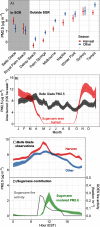Impacts of Sugarcane Fires on Air Quality and Public Health in South Florida
- PMID: 35929976
- PMCID: PMC9354838
- DOI: 10.1289/EHP9957
Impacts of Sugarcane Fires on Air Quality and Public Health in South Florida
Abstract
Background: Preharvest burning of sugarcane is a common agricultural practice in Florida, which produces fine particulate matter [particulate matter (PM) with aerodynamic diameter ()] that is associated with higher mortality.
Objectives: We estimated premature mortality associated with exposure to from sugarcane burning in people age 25 y and above for 20 counties in South Florida.
Methods: We combined information from an atmospheric dispersion model, satellites, and surface measurements to quantify concentrations in South Florida and the fraction of from sugarcane fires. From these concentrations, estimated mortalities attributable to from sugarcane fires were calculated by census tract using health impact functions derived from literature for six causes of death linked to . Confidence intervals (CI) are provided based on Monte Carlo simulations that propagate uncertainty in the emissions, dispersion model, health impact functions, and demographic data.
Results: Sugarcane fires emitted an amount of primary similar to that of motor vehicles in Florida. from sugarcane fires is estimated to contribute to mortality rates within the Florida Sugarcane Growing Region (SGR) by 0.4 death per 100,000 people per year (95% CI: 0.3, 1.6 per 100,000). These estimates imply 2.5 deaths per year across South Florida were associated with from sugarcane fires (95% CI: 1.2, 6.1), with 0.16 in the SGR (95% CI: 0.09, 0.6) and 0.72 in Palm Beach County (95% CI: 0.17, 2.2).
Discussion: from sugarcane fires was estimated to contribute to mortality risk across South Florida, particularly in the SGR. This is consistent with prior studies that documented impacts of sugarcane fire on air quality but did not quantify mortality. Additional health impacts of sugarcane fires, which were not quantified here, include exacerbating nonfatal health conditions such as asthma and cardiovascular problems. Harvesting sugarcane without field burning would likely reduce and health burdens in this region. https://doi.org/10.1289/EHP9957.
Figures






Comment in
-
Comment on "Impacts of Sugarcane Fires on Air Quality and Public Health in South Florida".Environ Health Perspect. 2023 Feb;131(2):28001. doi: 10.1289/EHP12236. Epub 2023 Feb 20. Environ Health Perspect. 2023. PMID: 36802828 Free PMC article. No abstract available.
-
Response to "Comment on 'Impacts of Sugarcane Fires on Air Quality and Public Health in South Florida'".Environ Health Perspect. 2023 Feb;131(2):28002. doi: 10.1289/EHP12800. Epub 2023 Feb 20. Environ Health Perspect. 2023. PMID: 36802829 Free PMC article. No abstract available.
Similar articles
-
Health burden of sugarcane burning on agricultural workers and nearby communities.Inhal Toxicol. 2024 May;36(5):327-342. doi: 10.1080/08958378.2024.2316875. Epub 2024 Feb 13. Inhal Toxicol. 2024. PMID: 38349733 Free PMC article. Review.
-
Source apportionment of atmospheric polycyclic aromatic hydrocarbons (PAHs) in Palm Beach County, Florida.J Air Waste Manag Assoc. 2016 Apr;66(4):377-86. doi: 10.1080/10962247.2016.1138902. J Air Waste Manag Assoc. 2016. PMID: 26745031
-
Comment on "Impacts of Sugarcane Fires on Air Quality and Public Health in South Florida".Environ Health Perspect. 2023 Feb;131(2):28001. doi: 10.1289/EHP12236. Epub 2023 Feb 20. Environ Health Perspect. 2023. PMID: 36802828 Free PMC article. No abstract available.
-
Response to "Comment on 'Impacts of Sugarcane Fires on Air Quality and Public Health in South Florida'".Environ Health Perspect. 2023 Feb;131(2):28002. doi: 10.1289/EHP12800. Epub 2023 Feb 20. Environ Health Perspect. 2023. PMID: 36802829 Free PMC article. No abstract available.
-
Wildfire and prescribed burning impacts on air quality in the United States.J Air Waste Manag Assoc. 2020 Jun;70(6):583-615. doi: 10.1080/10962247.2020.1749731. J Air Waste Manag Assoc. 2020. PMID: 32240055 Free PMC article. Review.
Cited by
-
A Comment about Studying the Health Effects of Smoke Produced by Prescribed Fire.Am J Respir Crit Care Med. 2024 Dec 1;210(11):1383. doi: 10.1164/rccm.202408-1536LE. Am J Respir Crit Care Med. 2024. PMID: 39392780 Free PMC article. No abstract available.
-
Geographic patterns in wildland fire exposures and county-level lung cancer mortality in the United States.Int J Health Geogr. 2025 Apr 11;24(1):8. doi: 10.1186/s12942-025-00394-x. Int J Health Geogr. 2025. PMID: 40217528 Free PMC article.
-
Health burden of sugarcane burning on agricultural workers and nearby communities.Inhal Toxicol. 2024 May;36(5):327-342. doi: 10.1080/08958378.2024.2316875. Epub 2024 Feb 13. Inhal Toxicol. 2024. PMID: 38349733 Free PMC article. Review.
-
The Adverse Health Effects of Air Pollution from Sugarcane Burning: A Scoping Review of Observational and Experimental Evidence.Environ Health Perspect. 2025 Jan;133(1):16002. doi: 10.1289/EHP14456. Epub 2025 Jan 30. Environ Health Perspect. 2025. PMID: 39883532 Free PMC article.
-
Rural Roads to Cognitive Resilience (RRR): A prospective cohort study protocol.medRxiv [Preprint]. 2024 Oct 14:2024.10.13.24315411. doi: 10.1101/2024.10.13.24315411. medRxiv. 2024. Update in: PLoS One. 2025 Jan 13;20(1):e0312660. doi: 10.1371/journal.pone.0312660. PMID: 39484275 Free PMC article. Updated. Preprint.
References
-
- Achtemeier GL. 1996. Results from a field study of Florida sugar cane prescribed fires. 22nd Conference on Agriculture & Forest Meteorology with Symposium on Fire and Forest Meteorology, 28 January–2 February 1996. Atlanta, Georgia, 268–271.
-
- Achtemeier GL, Adkins CW. 1997. Ash and smoke plumes produced from burning sugar cane. Sugar Cane 2:16–21.
-
- Achtemeier GL, Goodrick SA, Liu Y, Garcia-Menendez F, Hu Y, Odman MT. 2011. Modeling smoke plume-rise and dispersion from Southern United States prescribed burns with Daysmoke. Atmosphere 2(3):358–388, 10.3390/atmos2030358. - DOI
Publication types
MeSH terms
Substances
Grants and funding
LinkOut - more resources
Full Text Sources
Medical

